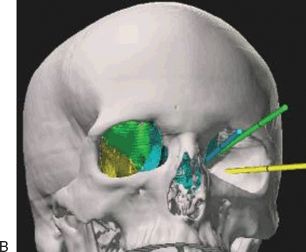FIGURE 15.1 Four- to six-handed surgical technique. By combining pathways of different length and position, increased space between hands and instruments is provided.
The decision on the pathway(s) to use should be based on the location and characteristics of the target pathology, preferably without preexisting bias for a given approach. By performing preoperative pathway analysis using navigation software, the spectrum of approaches (monoportal or multiportal) offered by various surgical trajectories can be analyzed and optimized for each patient’s individual pathology. A combination of approaches can be selected that will avoid endangering critical structures and optimize the surgeon’s ability to visualize and access challenging lesions using minimally disruptive technique. Virtual endoscopy can then be performed before surgery to confirm the appropriateness of the approaches and visualize the critical structures that will be encountered.
The techniques that we use for these approaches are transorbital, not transpalpebral. The term transorbital refers to approach vectors that access or traverse the orbit without removing bone of the orbital rim or adjacent structures. The term transpalpebral refers to approaches that employ incisions that partly or completely transect an eyelid. Thus, supraorbital craniotomies can be performed with a transpalpebral incision, though the approach is not transorbital. The SLC incision described herein is a transpalpebral incision, but the approach is strictly transorbital. We have found that removing the bone of the orbital rim and adjacent structures requires more extensive incisions, creates more morbidity, and prolongs the recovery period. Furthermore, we have found from computer analysis, cadaver studies, and clinical experience that the surgical approach vector is typically not improved by excising more bone.
This chapter describes our system of transorbital approaches to the ACF and suggests ways of combining these and other approaches in multiportal technique to maximize the surgeon’s ability to visualize and instrument these complex surgical targets with minimal disruption. Our transorbital approaches to the MCF are described in Chapter 34 of this book.
HISTORY
The history of patients presenting with ACF lesions is highly dependent on the type of pathology. When the orbit is involved, pain, diplopia, diminished visual acuity, proptosis, and ptosis are common presenting symptoms. A prior history of ophthalmologic problems and treatment should be noted. If the pathology involves the nasal cavity or sinuses, drainage, epistaxis, and loss of olfaction are common. Headache is a common nonspecific symptom, while decreased facial sensation may indicate involvement of the trigeminal nerve by tumor. Trismus may signify spread of tumor into the pterygomaxillary space or infratemporal fossa.
PHYSICAL EXAMINATION
A complete head and neck and neurologic examination is mandatory, with special attention to the cranial nerves. Regional lymph nodes should be examined for signs of metastatic cancer. For pathology that might encroach on the nasopharynx or nasal cavity, fiberoptic nasopharyngoscopy should be undertaken. The globes and orbits should be examined, and visual acuity should be checked. Asymmetry of orbital volume, position of the globe, size and reactivity of the pupils, and position of the eyelid should be noted. Normal extraocular muscle function should be confirmed. Strong consideration should be given to preoperative evaluation by an ophthalmologist to search for subclinical disease or other contraindications before transorbital surgery is undertaken.
INDICATIONS
Transorbital endoscopic surgery may be indicated for the treatment of pathology involving structures within or adjacent to the orbit. It can also be used as a pathway to more distant structures when it lies in the vector between the pathway entry point and the surgical target. It can be used as a single approach or combined with transnasal, transmaxillary, or supraorbital portals. It may also be used as an adjunct to a traditional craniotomy or subfrontal craniectomy. As part of a multiportal approach, the transorbital pathway can be used for visualization (endoscopy), instrumentation, or both to provide the best possible means of safely manipulating the surgical target.
A more recent application of the transorbital approaches is the surgical treatment of orbital, frontal, sinus, and intracranial manifestations of sinogenic infections such as epidural abscesses (see Suggested Readings). The indications of these procedures are expanding with further work in the laboratory and improvements in surgical technology.
CONTRAINDICATIONS
The two absolute contraindications to transorbital endoscopic surgery are found in trauma patients: a ruptured globe or hyphema (blood in the anterior chamber of the eye). Relative contraindications to undertaking these approaches are noted below, and these patients should be managed in consultation with an ophthalmologist.
- Intraocular surgery within the last 6 months (e.g., cataract, retinal, glaucoma, or corneal transplantation surgery); consult with the ophthalmic surgeon before proceeding.
- Orbital infection (risk of posterior spread of the infection).
- Severe orbital inflammation or congestion (decreased space for retraction within the orbit may lead to increased pressure on the globe and optic nerve).
- Patients with diminished corneal sensation from previous laser corneal surgery or other cause may be at increased risk for postoperative complications.
- Other orbital pathology that creates a mass effect or alters anatomy in a manner that could obstruct endoscopic access.
Glaucoma and dry eye do not appear to be contraindications to transorbital pathways, though increased care should be given to lubrication of the ocular surface during and after surgery. Consultation with the ophthalmologist is an important aspect in the care of patients with these conditions.
PREOPERATIVE PLANNING
Full radiographic imaging should be obtained to completely evaluate and characterize the pathology in question including its exact location, extent, and vascularity when indicated. Imaging for intraoperative surgical navigation should be undertaken and should include computed tomography (CT) and magnetic resonance imaging (MRI) so that fusion guidance can be obtained as needed. Preoperative analysis of the navigation images on a computer planning station is helpful to investigate the ideal surgical approach or approaches to the target. Depending on the software, this may include highlighting the pathology, analyzing the target three-dimensionally, and performing a vector analysis of the possible approaches with virtual endoscopy.
Among the factors to consider in choosing a surgical approach are the following:
- Critical structures involved with or adjacent to the pathology.
- Adequacy of exposure for passage of instruments.
- Ability to visualize the pathology from the approach angle.
- Absence of impediments to visualization or manipulation of the target.
- Ability to instrument the target from the approach angle.
- Morbidity caused by creation of the pathway.
- Ability to reconstruct defects created by the pathway or target manipulation.
- The pathway should not cross critical neurovascular structures in a manner that can expose them to pressure or other trauma.
- A shorter pathway may allow increased ease of target visualization and manipulation.
- Adequacy of exposure for four- to six-handed (four to six function) surgery as needed.
- Experience of the surgical team.
- Patient preference.
For planning surgical approaches, we consider the number of surgical functions that will be required. These functions typically involve illumination/visualization (endoscopy), aspiration, irrigation, ablation, retraction, and manipulation. The literature on skull base surgery typically describes the need for “four-handed” surgery, that is, the ability for two surgeons to work together during the procedure. While this is a critical concept, there are times when more than four “hands” may be desirable to carry out a task. To address this, developments in surgical technology have provided instruments that can carry out multiple tasks. Thus, a single instrument such as a microdebrider may provide aspiration, irrigation, and tissue ablation, providing three functions in one “hand.” There are times when by using a multifunctional instrument, a single surgeon can perform five or more functions using two hands (illumination and visualization in one hand, with irrigation, bone aspiration, and suction in the other). We emphasize, therefore, the number of surgical functions required when planning the surgical pathway.
When possible, an approach that is coplanar with the target is beneficial (Fig. 15.2). A coplanar approach consists of an entry portal, dissection pathway, and surgical target that all lie within a single axial, sagittal, or coronal plane, such as one that might be visualized on a single CT image. For example, if a lesion is located immediately superior to the planum sphenoidale, a surgical approach that allows dissection along the ACF through a PC portal will simplify the procedure by allowing for the creation of an epidural pathway along the bone of the ACF without the need to use angled endoscopy or instrumentation.
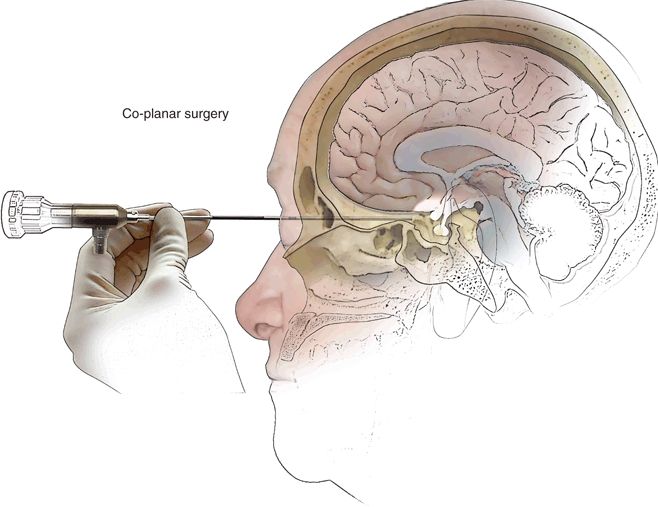
FIGURE 15.2 Coplanar surgery. The approach and target are on the same surgical plane.
Our choice of surgical portal is based on a division of the orbit into four quadrants, each of which has a specific entry portal (Fig. 15.3A). These are the superior, medial, inferior, and lateral quadrants. The approach is chosen based on the quadrant that is directly involved with the pathology or is transgressed by the optimal pathway to the surgical target (Fig. 15.3C). A schematic of the surgical portals and skull base regions of access is demonstrated in Figure 15.4. The approaches to the lateral and inferior quadrants are used primarily for access to the MCF and adjacent structures––these are described in Chapter 34 on transorbital approaches to the MCF.
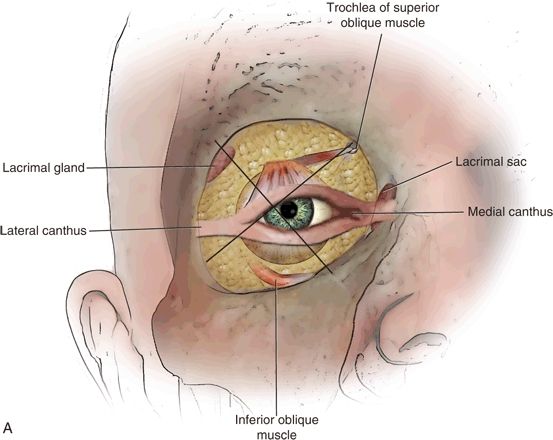
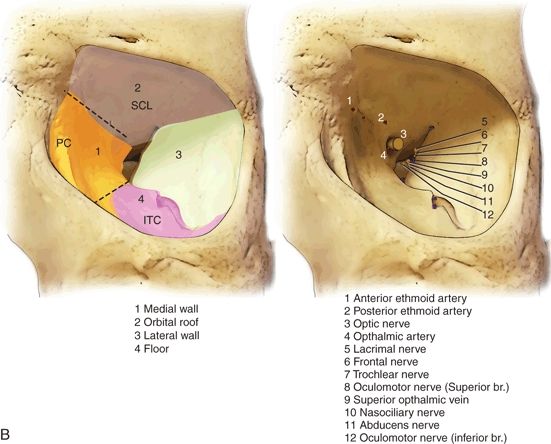
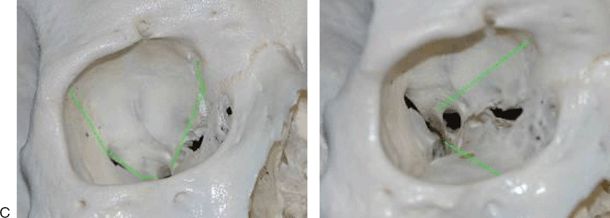
FIGURE 15.3 A. The four quadrants of the orbit. The surgical approach is chosen by the quadrant of the orbit that is most involved by the underlying pathology. The superior quadrant is accessed by the superior lid approach (SLC) approach; the medial quadrant is entered through a precaruncular (PC) incision. The inferior quadrant approach is made through an inferior transconjunctival (ITC) dissection, and the lateral quadrant is reached through a lateral retrocanthal (LRC) gateway; these are discussed in Chapter 37. B. Surgical anatomy of the orbit. The optic nerve is located in the medial orbital wall, medial and slightly superior to the junction of the superior and inferior fissures. Note that the anterior and posterior ethmoid arteries are coplanar with the optic nerve and demonstrate the level of the skull base. Dotted lines/arrows demonstrate approximate borders between the superior lid crease (SLC), precaruncular (PC), and inferior transconjunctival (ITC) approaches. 1, medial wall; 2, orbital roof; 3, lateral wall; 4, floor. C. Left. Green lines demonstrate approximate region that is accessed in SLC approach. Right. Approximate region that is accessed in PC approach (note the level of the ACF that is visible through the dehiscent lamina). Part or all of this bone can be removed as a pathway to adjacent targets.

